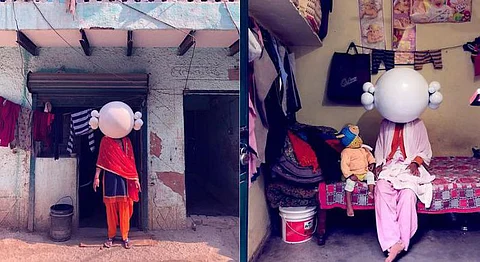
- HOMEGROWN WORLD
- #HGCREATORS
- #HGEXPLORE
- #HGVOICES
- #HGSHOP
- CAREERS
- ABOUT US
- CONTACT US

Art can take multiple forms, and yet give out the same message –– whether it be performative, visual or any other kind, what is conveyed to the consumer has the potential to remain constant. It is one of the many things we love about art –– the ability to shapeshift but maintain its integrity throughout.
Princess Pea, an anonymous artist, rose to fame in 2009 after she paraded nonchalantly around India Art Fair in Delhi with a large pea-shaped helmet (of sorts) around her head. She is now an artist that creates contemporary, impactful and meaningful art –– borrowing from feminism and rooted in storytelling, she not only explores several female narratives around India, but also creates simplistic, yet extremely impressive toys that signify the complexities of women.
Her anonymity created intrigue, but since then, it has created much more than just that. We wonder, even after nearly 12 years, why she chooses to remain anonymous.
“Living in this world where everything is accessible, as an artist I found this interesting to be discreet, or unavailable. The idea of anonymity works in itself. Being anonymous gives me immense space and pleasure. As Carl Jung framed, the mind is a house to many rooms, as a realization, I have discovered more rooms that I can go into,” she says.
All these years later, it remains just as important. She continues, “From what began as a means of world-building from the perspective of Princess Pea in my early years, I have moved towards a more collaborative, time-based, and intervention-led practice.”
The power held by women-led narratives is immense –– a story need not be extraordinary to prove strength and resilience, and Princess Pea’s exploration of the same has proved it. Her practice, as one can feel, is not rebellious –– rather, it is almost as if it is highly focused and calm, by way of wanting to express the intricacies of female identities.
She says, “My practice has moved into thinking about the politics and aesthetics of care, women-led narratives of self, and economies of domestic life amongst women and children. A continuation to my earlier works, I seek to build community and raise voices that have cultural and sociopolitical connotations, in the telling of this tale of the ‘ideal’ feminine.”
Princess Pea’s latest toy sculpture ‘Daadi’ is a special one –– she is apt when she says that it ‘becomes accessible, visible, a conversation starter, a question, as a symbol of today’s angst.’ Inspired by Bilkis Daadi of Shaheen Bagh, the toy is a symbol of resilience and sheer courage, as portrayed by the many grandmothers that protested against the CAA and NRC. It is surely more than a still figure –– the work put into it by local female artisans of Andhra Pradesh increases its beauty tenfold. Their hard work and knowledge of the craft lends much of the soul to ‘Daadi’, and Princess Pea recognises it wholeheartedly.
She opines, “I always believed that a lot can be done in craft with local skills as I feel that we as a community have failed to respect and provide new avenues for these indigenous rituals.”
Further explaining what goes into the making of ‘Daadi’, she says, “The design takes many iterations, sometimes more than six months to see the real piece in my hand. The work is done in a small setup in a village and the designs are shared and quality check is key. As they all are scrubbed into shape manually, joined together, each essential element is thought out to fit the dimensions. We cannot match a factory machine-made mass object, rather it’s a completely emotional process to see them coming to life.”
We would like to believe that Princess Pea’s art narrates tales of women in a way apart from the ordinary –– from embracing their individuality to expressing the power of a collective. Through stories, toys, or even her large pea-head that grants anonymity, she succeeds at bringing about small waves of change –– change in perspectives and mindsets, and in today’s India, that is harder to achieve than ever.
Contemporary art suits Princess Pea, but what we admire about her and her work is that neither does it stick to a particular contemporary style, nor does it make way for critique in expression. For how natural, raw and real the stories she portrays are, there is not much to falter.
Anonymity only plays to Princess Pea’s hands –– not just in terms of her personal journey, but also of her stories. Even if these identities were on show, nothing could flout their graceful, robust and bold nature.
If you enjoyed reading this, we suggest you also read:
